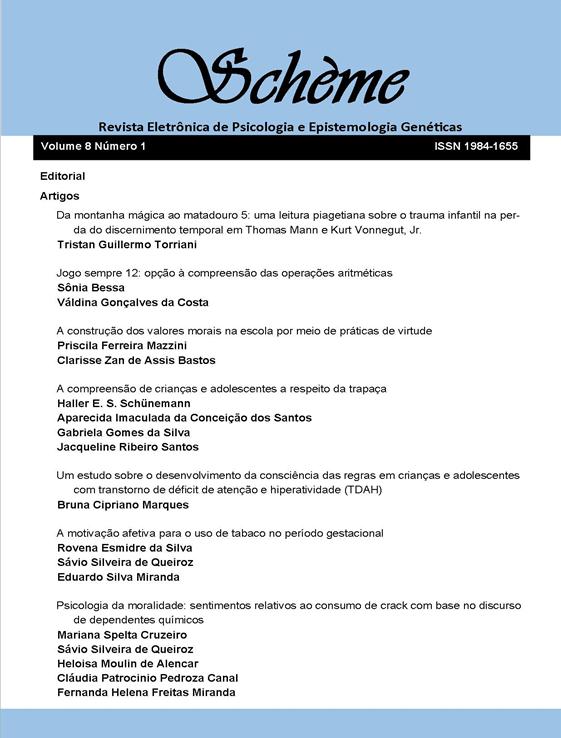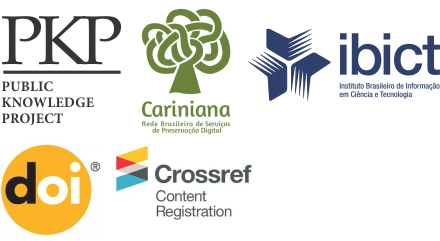DA MONTANHA MÁGICA AO MATADOURO 5:
UMA LEITURA PIAGETIANA SOBRE O TRAUMA INFANTIL NA PERDA DO DISCERNIMENTO TEMPORAL EM THOMAS MANN E KURT VONNEGUT, JR.
DOI:
https://doi.org/10.36311/1984-1655.2016.v8n1.02.p5Palavras-chave:
Trauma infantil; Piaget, J.; Mann, T.; Vonnegut, Jr., K.; Tempo.Resumo
A desestruturação traumática da vivência espaço temporal explorada literariamente em A Montanha Mágica de Thomas Mann e Matadouro 5 de Kurt Vonnegut, Jr. pode ser investigada a partir do trabalho de P. Zimbardo, L. Terr e da Terapia Cognitivo-Comportamental sobre o trauma infantil e a concepção piagetiana do período pré-operacional, marcado por egocentrismo e assimilação lúdica. Na primeira obra, o protagonista Hans Castorp sofre traumas seguidos na perda da mãe, do pai e do avô, e permite, mais tarde, que sua experiência subjetiva do tempo se desassocie gradualmente da medida intersubjetiva ("objetiva") do tempo. Em Matadouro 5, o protagonista Billy Pilgrim passa por traumas que geram rupturas e saltos (tanto para frente quanto para trás) na sua experiência linear do tempo. Concluímos o estudo comparativo destacando as similaridades entre os romances.
Downloads
Referências
1991.
ALLEN, W. R. Understanding Kurt Vonnegut. Columbia: University of South Carolina
Press, 1991.
AMES, V. M. The Humanism of Thomas Mann. The Journal of Aesthetics and Art Criticism, v. 10, n.3, p. 247-257, 1952.
BEHARRIEL, F. J. Psychology in the Early Works of Thomas Mann. PMLA, v. 77,
n.1, p. 149-155, 1962.
BEDDOW, M. The Magic Mountain. In: ROBERTSON, R. (ed.) The Cambridge Companion to Thomas Mann. Cambridge, UK: CUP, 2003, p. 137-150.
BLOOM, H. (ed.). Kurt Vonnegut’s Slaughterhouse-five. Bloom's Guides. NY: Chelsea
House, 2007.
BROWN, K. The Psychiatrists Were Right: Anomic Alienation in Kurt Vonnegut's
Slaughterhouse-Five. South Central Review, v.28, n. 2, p. 101-109, 2011.
BRUFORD, W.H. "Bildung" in The Magic Mountain. In: BLOOM, Harold (ed.).
Thomas Mann's The Magic Mountain. Modern Critical Interpretations. NY: Chelsea
House, 1986, p. 67-83.
CORDLE, D. Changing of the Old Guard: Time Travel and Literary Technique in the
Work of Kurt Vonnegut. The Yearbook of English Studies, v. 30 (Time and Narrative),
p. 166-176, 2000.
FLAVELL, J. H. A psicologia do desenvolvimento de Piaget. 3ª edição. São Paulo: Pioneira, 1988.
FONTANELLA, M. A. R. A montanha mágica como Bildungsroman. Dissertação de
Mestrado. IEL/UNICAMP, Campinas, SP: 2000.
HICK, C. Vom Schwindel ewiger Gegenwart: zur Pathologie der Zeit in Thomas Manns
"Zauberberg". In: ENGELHARDT, D.; WISSKIRCHEN, H. (eds.). "Der Zauberberg" -
die Welt der Wissenschaften in Thomas Manns Roman. Stuttgart: Schattauer, 2003, p.
71-106.
HOLLON, S. D.; GARBER, J. Cognitive Therapy. In: ABRAMSON, L. Y. (ed.). Social
Cognition and Clinical Psychology: A synthesis. NY: Guilford, 1988, p. 204-253.
34
Volume 8 Número 1 – Jan-Jul/2016
www.marilia.unesp.br/scheme
ISSN: 1984-1655
JAMESON, F. Archeologies of the Future. The Desire Called Utopia and Other Science
Fictions. London & NY: Verso, 2005.
JOAS, H.; KNÖBL, W. Kriegsverdrängung: Ein Problem in der Geschichte der Sozialtheorie. Frankfurt am Main: Suhrkamp, 2008.
KAVALOSKI, J. Performativity and the Dialectic of Time in Thomas Mann's Der Zauberberg. German Studies Review, v. 32, n. 2, p. 319-342, 2009.
LAING, R. D. O Eu dividido. Vozes: Petrópolis, 1973.
LEE, D.; TURNER, S. Cognitive-behavioural models of PTSD. In: BLACK, D.;
NEWMAN, M.; HARRIS-HENDRICKS, J.; MEZEY, G. (eds.). Psychological Trauma: A Developmental Approach. Glasgow: Gaskell, 1997, p. 64-80. Republicado em
MILLER, D.; GREEN, J. The Psychology of Sexual Health. London: Wiley-Blackwell,
2002.
MANN, K. Minhas Memórias Inescritas. Tradução de Claudia Baumgart. SP: Ars Poetica Editora, 1992.
MANN, T. Der Zauberberg. Roman. Frankfurt am Main: Fischer, 2007.
MANN, T. A montanha mágica. Tradução de Herbert Caro. RJ: Nova Fronteira, 1980.
NENNO, N. P. Projections on Blank Space: Landscape, Nationality, and Identity in
Thomas Mann's Der Zauberberg. The German Quarterly, v. 69, n. 3, p. 305-321, Summer, 1996.
PIAGET, J. A formação do símbolo na criança: imitação, jogo e sonho, imagem e representação. Tradução de Álvaro Cabral e Christiano Monteiro Oiticica. 4ª ed. Rio de
Janeiro: LTC, 2010.
______. A noção de tempo na criança. 2ª ed., Tradução de Rubens Fiúza, RJ & SP: Record, 2002.
______. A representação do mundo na criança. Tradução de Rubens Fiúza. RJ: Record,
1926.
______. Relações Entre a Afetividade e a Inteligência no Desenvolvimento Mental da
Criança. Tradução de Cláudio J. P. Saltini; Doralice B. Cavenaghi. RJ: Editora Wak,
2014.
______. O raciocínio na criança. Tradução de Valerie Rumjanek Chaves. Rio de Janeiro: Record, 1967.
35
Volume 8 Número 1 – Jan-Jul/2016
www.marilia.unesp.br/scheme
ISSN: 1984-1655
PRAGER, D. N. Orienting the Self: The German Literary Encounter with the Eastern
Other. Rochester, NY: Camden House, 2014.
RESICK, P. A.; SCHNICKE, M. K. Cognitive processing therapy for sexual assault
victims. Journal of Consulting and Clinical Psychology. v. 60, n. 5, p. 748-756, 1992.
RICOEUR, P. Temps et récit. Tome II. La configuration dans le récit de fiction. Paris:
Éditions du Seuil, 1984.
RIGNEY, A. All This Happened, More or Less: What a Novelist Made of the Bombing
of Dresden. History and Theory, v. 48, n. 2, Theme Issue 47: Historical Representation
and Historical Truth, p. 5-24, 2009.
ROSENFELD, A. Letras e Leitura. SP: Perspectiva e EDUSP; Campinas: Editora da
UNICAMP, 1994.
SCHOEPF, J. Die pädagogischen Konzepte in Thomas Manns "Zauberberg" und ihre
Wirkung auf die Hauptfigur Hans Castorp. Marburg: Tectum Verlag DE, 2001.
RODRIGUES, M. A. S. A representação do tempo no romance Der Zauberberg de
Thomas Mann. Dissertação de mestrado. FFLCH/USP: São Paulo, 2008.
TERR, L. C. Childhood traumas: an outline and overview. Am J Psychiatry, v. 1, n.
148, p. 10-20, 1991.
VEES-GULANI, S. Diagnosing Billy Pilgrim: A Psychiatric Approach to Kurt Vonnegut's Slaughterhouse-Five. Critique v. 44, n. 2, p. 175-184, 2003.
VONNEGUT, JR., Kurt. Slaughterhouse 5 or The Children's Crusade. A duty-dance
with Death. London: Vintage, 1991.
VONNEGUT, JR., K. Matadouro n. 5: ou, A cruzada das crianças: uma dança de etiqueta com a morte. Tradução de George Gurjan. Rio de Janeiro, RJ: Artenova, 1972.
WINNICOTT, D.W. O Brincar e a Realidade. RJ: Imago, 1975.
ZIMBARDO, P. G.; BOYD, J. N. Putting Time in Perspective: A Valid, Reliable Individual-Difference Metric. In: The Journal of Personality and Social Psychology, v. 77, n. 6, p. 1271-1288, 1999.





